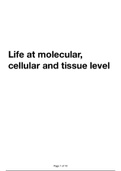Life at molecular,
cellular and tissue level
Page 1 of 10
,Introduction to nucleic acids
Called the molecules of life
Function of nucleic acids
Nucleic acids store the information that controls cellular activity and the development of an entire
organism. They do this by controlling the synthesis of proteins (see protein synthesis later)
Because enzymes are proteins, they control chemical processes inside cells and ultimately control the
structure and functioning of all living organisms.
2 types of nucleic acids:
1. Deoxyribose nucleic acid
2. Ribonucleic acids
Deoxyribose nucleic acids (DNA)
Background information
The discovery of DNA
- London, early 1950’s
- Maurice Wilkins and Rosalind Franklin looked using xray crystallography (diffraction images of DNA)
- At the same time, Francis Crick and James Watson analysed Franklin’s data and arranged a twisted ladder model
(double helix)
Genetic replication discovery
- Watson and Crick developed ideas about genetic replication, including
- Pairing of bases
- Triplet code used in reading material (Crick and Sydney Brenner)
- ^^ Proved DNA molecules can replicate (exact copies) and carry genetic instructions
- The noble prize given to Wilkins, Crick and Watson (Franklin died of cancer when she was 37)
The DNA molecule
Where is DNA?
Found mainly in the nucleus
Molecule is piled so that it can fit inside the nucleus
Forms an important part of chromosones that make up the chromatin network
*Chromatin: chromosomal material made of DNA & histone proteins as found in a non dividing cell
Extranuclear DNA
Small amounts of DNA found outside the nucleus in mitochondria (in plants and animals) and chloroplasts
(in plants)
How is DNA made up?
Long twisted ladder shape
3D double helix
A DNA molecule is a long chain (polymer) made up of small units (monomers)
The monomer of a DNA molecule is a nucleotide, each nucleotide is made of:
• sugar molecule - deoxyribose (deoxy-2 oxygen) (S)
• phosphate molecule (P)
• nitrogenous base which can be:
- adenine Remember
- thymine Apples in the Tree
- guanine Cars in the Garage
- cytosine
*Monomers: Like building blocks, small units that make up polymers
Page 2 of 10
, Nitrogenous bases
- The nitrogenous bases are the foundation of the genetic code. Them and their order instruct cells on
how to synthesise proteins.
- As there are 4 nitrogenous bases, there are four different nucleotides.
- 4 nucleotides are the same in all animals and plants
- Nucleotides join by condensation (removal of a water molecule)
2 groups of nitrogenous bases - purines and pyrimidines
Purines
→ Made of 2 fused rings (nitrogen, carbon, hydrogen atoms) eg. guanine and adenine
Pyrimidines
→ Made of one ring of similar atoms, therefore smaller than purines eg. thymine, cytosine and uracil (see
RNA for uracil)
A base pair is made up of one pyrimidine and one purine
1) thymine and adenine, 2 hydrogen bonds
2) cytosine and guanine, 3 hydrogen bonds
Purine and pyrimidine similarities
• Both made of N,C,H
• Both made of rings
The structure of DNA
The double helix
- outer 2 strands formed by chain of alternating sugar/phosphate links, for which the bonds are strong
- rungs of ladder → base pairs (GC, AT), for which bonds are weak, hydrogen bonds
- base pairs attached to sugar molecules
How do organisms differ?
The difference is the sequence of nucleotides, which determines the genetic code of an organism.
What is the role of DNA?
1. Carry hereditary information in the form of genes
2. Provides blueprint for organisms growth by coding for protein synthesis (see later)
3. Can replicate, so that copies of genetic info can be passed down
However, only 2% of DNA actually codes for proteins
The other 98% is non-coding
Protein coding regions are called axons
^ Interrupted by non coding regions called introns
Complex organisms have much more non-coding DNA than simple
Non-coding DNA form functional RNA molecules with regulatory functions
Page 3 of 10





